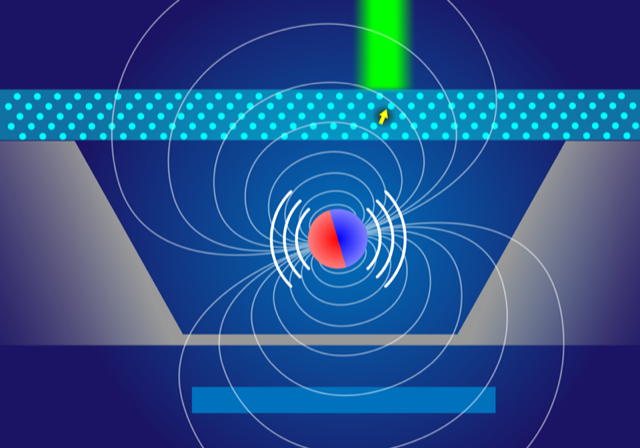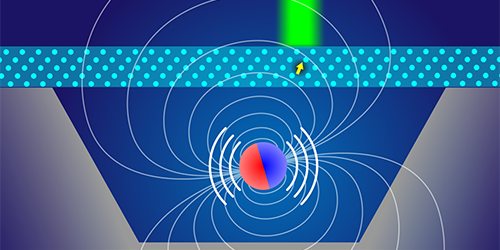Hooking a Magnet to an Electron
A team of researchers has demonstrated a magnetic coupling between a levitating magnet and a single electron. The electron, which is housed in a diamond crystal, responds to the motion of the magnet through an observable change in the light it emits. The team is currently working on increasing the strength of the magnet-electron interaction by shrinking their device, which they say could allow it to probe fundamental quantum questions and could make it useful for quantum computers.
One way to induce quantum behavior in an object is to apply a force that simultaneously pushes and pulls on the object, causing it to move left and right at the same time, says Jan Gieseler of Harvard University. Researchers know how to do this push-and-pull for single atoms but not for larger objects. Gieseler and his colleagues think their new device could induce this quantum behavior in a micrometer-sized magnet. The magnet wiggles around inside a magnetic trap, and the team has now shown that this vibrational motion alters the energy of a nearby electron in a measurable way. By increasing the strength of this interaction, the magnet could inherit quantum behaviors from the electron, like moving left and right simultaneously, and that could allow researchers to test the laws of quantum mechanics for heavy objects, Gieseler says.
To make their device, Gieseler and his colleagues etched an 80-micrometer-deep pit—resembling a pool table pocket—into a silicon wafer. They inserted a 15-micrometer-wide, spherical magnet into the pit and covered it with a slab of diamond, to make a flat roof. The diamond contained an atom-like defect, known as a nitrogen-vacancy center, which includes an unpaired electron. The researchers controlled the defect with microwaves, essentially making the electron more responsive to the field of the magnet.
To bring the magnet close to this electron, the researchers placed a slab of the superconductor yttrium barium copper oxide underneath the pit. Permanent magnets are repelled by superconductors, so the magnet was pushed upward and hovered a few tens of micrometers below the diamond roof. The superconductor’s magnetic field also created a trap in which the magnet vibrated back and forth.
The team used two methods to monitor the magnet’s motion. The first involved recording high-frame-rate videos of the magnet, from which they determined the vibrational frequency to be around 1 kHz. The second involved shining green light on the defect that contained the electron and recording the red light that the defect subsequently emitted. The intensity of this emitted light oscillated up and down with the same frequency as the magnet’s vibrations, confirming that the electron was sensitive to the position of the magnet. “This is the first time that a levitated particle has been shown to interact with an external atom-like defect,” Gieseler says.
By comparing the video and emission measurements, the team found that the electron-magnet interaction strength was 50 mHz. This quantity is typically written as a frequency because it characterizes the rate at which one system senses a change in the other. Gieseler notes that the interaction strength in their device is modest compared to the 20 Hz possible for other devices that take advantage of similar effects. But he says that by using a smaller magnet—something the team is currently working on—and by making cleaner diamond defects, they should be able to reach interaction strengths of around 10 kHz. Shrinking the magnet by a factor of 10 could also allow them to see quantum effects directly in the device. For example, the interaction between the electron and magnet could endow the magnet with the electron’s quantum property of simultaneously being in two places at once, Gieseler says.
The demonstration is “impressive,” says Benjamin Pigeau, a nano-optics expert at the Néel Institute in France. Like Gieseler and his colleagues, Pigeau thinks that the device holds promise for investigating the quantum behavior of macroscopic objects. Given the sensitivity of the trapped magnet to magnetic fields, he also thinks that the device could find use as a precise magnetometer.
This research is published in Physical Review Letters.
–Katherine Wright
Katherine Wright is the Deputy Editor of Physics Magazine.





